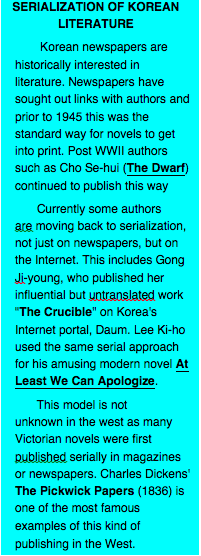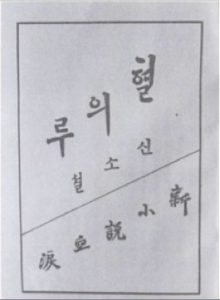Korean Fiction Chapters: 1 / 2 / 3 / 4/ 5 /
In 1877 King Gojong and Queen Min sent a group of Koreans to Japan to examine its technological and social changes. What they found amazed them, as while Korea had once considered itself the modern hub of Asia, Japan had modernized far beyond Korean expectations or experience. While Queen Min determined that Korea should embark on a program of modernization, it was strenuously opposed by many yangban who, correctly, saw it as a threat to the Confucian society in which they had prospered. At the same time there were also some yangban who supported modernization, and formed the Progressive Movement towards the conclusion of the 1870’s. This group supported social and economic modernization including, controversially, equality of women.
Against this backdrop Korea began its first foray into modern literature. Some Korean critics date the Enlightenment Era back as far as 1860, arguing that at this time even the traditional literati, who still wrote in Chinese, were beginning to include themes or rebirth and enlightenment. At the same time the Tonghak Movement was founded by Ch’oe Che-u, in neo-Confucian reaction to “Western learning”. As the century continued to wind down, the force of the enlightenment grew, cresting in the last decade of the century, where some other critics date the beginning of the Enlightenment proper. But whenever one dates it from, the enlightenment period was contested and brief. Worse, it was violently distorted by Japanese colonialism. However, the massive, self-conscious efforts made during this era demonstrates that Korea was trying to figure out a way towards literary modernization, and it gives some hints of where that modernisation might have gone.
The so-called “New Novel” was a transitional form that developed partly in response to Korea’s increasing exposure to the outside world and prior to its complete colonialisation by Japan. By the 19th century the Joseon Dynasty was collapsing, the Japanese empire was rising, and western literary influences (albeit initially largely filtered through Japan and China) began to seep into Korean and affect Korean writers. China fell into less repute as intellectuals attempted to reconstruct Korea as an independent nation. This lead to, among other things, a strong repudiation of Chinese as the language of Korean literature although Chinese modern literature did continue to have an impact on Korean literature..
The shift in literature was greatly bolstered by two social movements, the New Education and Korean Language and Literature Movement. In 1894 the Gabo Reforms introduced a new western style of education. At the same time publishing technology was changing as newspapers were becoming increasingly important, providing the first lighting rod for the literature of the Enlightenment Era. In fact, serial novels were a common aspect of most newspapers of the era, which is why they should be considered as part of Korean Literature, or its development.
The first Korean newspaper was the Hansong Sunbo (1883) and the government also published, initially in Chinese but eventually in Hangul and Hanja. Many other ‘modernizing’ newspapers leapt into existence, including the Pak Mun-guk. This newspaper’s mission was to proliferate new ideas, but it was only published for five years. A one-hundred percent Hangul newspaper did not exist until 1894 when the King and Queen sponsored the weekly Ganjo Shimpo (The Seoul News). In 1896 the short-lived The Independent (1896-1899) was published in Hangul, then shut down by the government. In quick succession multiple newspapers bloomed, most going out of business in 1910, with the complete advent of Japanese colonization.
 Newspapers filled some of their pages with serialized novels, as well a sijo and kasa. The development of modern printing techniques made mercantile publishing possible. These developments allowed the possibility of the professional author, as opposed to the troubador, scholar, or didact of the classical era. Authors created a new form of literature call the sinsosol (new novel), and readers flocked to read these works. In addition, they printing press (which many historians point out was invented in Korea before Gutenberg got around to it) made it possible to print books, which became increasingly popular.
Newspapers filled some of their pages with serialized novels, as well a sijo and kasa. The development of modern printing techniques made mercantile publishing possible. These developments allowed the possibility of the professional author, as opposed to the troubador, scholar, or didact of the classical era. Authors created a new form of literature call the sinsosol (new novel), and readers flocked to read these works. In addition, they printing press (which many historians point out was invented in Korea before Gutenberg got around to it) made it possible to print books, which became increasingly popular.
Sinsosol works properly began in the mid-1890’s and focused on issues of popular control, the importance of education, attacks on arranged marriage, and attacks on the evil of “old” beliefs, including superstition. Subjects tended to be contemporary with descriptive and analytical styles which were different from the philosophical, narrative and chronological style of classical literature. Moral didacticism still filled these works with evil punished and good rewarded, and characters still tended to be archetypes and not individuals as at this point literature was almost entirely focused on issues of modernization over any character’s particular personal details. Heroes were made of modernizers, while conservatives were portrayed as evil. Happy endings also tended to predominate and plots were, at best, haphazardly constructed out of series of coincidence and random events. Still, in comparison to previous literature, these works had a new kind of reality removed from the cliched plots and characters of classical fiction. These works dealt with large problems in daily contexts and thus drew readership while at the same time creating a second generation of authors.
Kim Hyunggyu notes that these works were predominantly concerned with the issues of the time, comprising. “modernization, national strength, educational reforms and changes in social customs.” (Kim 115). In other words, as Korean literature would come to almost exclusively be, concerned with the precise on concrete problems of the era in which they were written or placed. Even biographical novels, typically about heroes, focused tightly on the importance of nationalism and modern awareness.
One of the first works of Korean enlightenment fiction was published in 1906. Yi In-jik’s Tears of Blood was serialized in The Independence News. It told the story of a family in P’yongyang suffering during the Sino-Japanese War. Although, as part of sinsosol, Tears of Blood was written by a male, it used a female protagonist to question the Choseon notions of women as property and not ‘citizens.’ In Tears of Blood a young girl becomes a symbol of a modern Korean nation, putting her in opposition to her older, more traditional mother. Here was one of the first stories of the culture clashes that were to come between traditionalists and those who wanted to create a new, modern, nation.
After Yi In-jik came Yi Kwang-su, building a bridge between the “new” and the “modern” novels, who would come to be considered the father of Korean modern literature, although also an incredibly controversial figure for political and philosophical reasons which will shortly be discussed. Yi Kwang-su advocated for shockingly modern beliefs including the scientific approach and romantic love.
Other authors followed and sinsosol, which were uniformly written in Hangul, continued to become more popular across this period. While these works were still strongly didactic – now most always espousing Enlightenment ideals – they broke with the abstractly contemplative and highly artificial novels of the classical period. The novels included new narrative techniques (e;g; ‘out of time’ narratives) and more prosaic voices.
Biographical works were also popular, although their focus changed to suit the tastes of the enlightenment audience, meaning calls to the emerging national consciousness and strong appeals to patriotism. Tale of the Patriotic Lady (Chang Ji-yon, 1907) was perhaps the most representative work of this genre.
The influence of the West often came through China and Japan, but more and more it became direct. In 1895 Yu Kiljun, the first Korean to study in both the US and Japan, published his Things Seen and Heard on a Journey to the West. In 1895, John Scarth Gale, a translator of impressive religious output, translated John Bunyan’s Pilgrims Progress into Korean. Gale was also the beginning of a paradigm shift in Korea, as he translated many religious works, part of the process by which Christianity was introduced into Korea. From 1895 on, Gale was busy producing translations of parts of the Bible, and in 1910 a complete Bible was finally translated and published in Korea. As partial fruit of Gale’s efforts, by the end of the 20th century, nearly 30% of the population is some form of Christian, well outstripping Buddhism.
By the 20th century it was clear that an important split had come between classical and modern literature. Schools had been established, including schools for women (Ewha), the scientific approach was increasingly prevalent, and formal study of the Korean language itself all conspired to change the nature of writers and what they wrote.
But as noted at the outset, this was quick and incomplete era of literature, because in 1910, Japan assumed complete colonial control of Korea, and by the March 1st Movement of 1919, the “new novel”, which was essentially a didactic form of entertainment, was completely replaced by the “modern novel” which increasingly, while not abandoning all the themes of the “new novel” incorporated more and more influences from Japanese and Modern literature, and increasingly focused on problems of national survival and/or naturalism, for reasons discussed after a detour in the next chapter to examine the role of translators in the success of Korean literature overseas.



